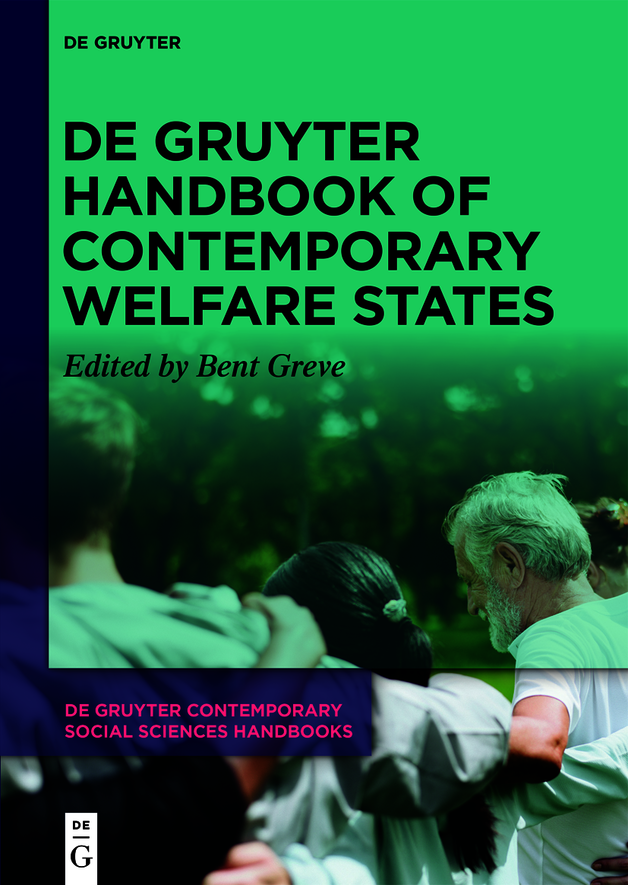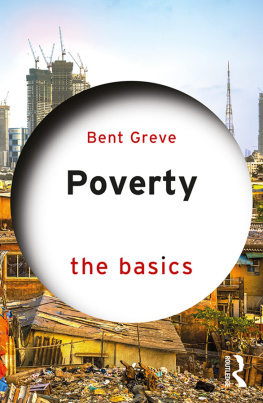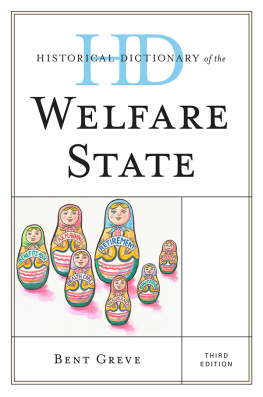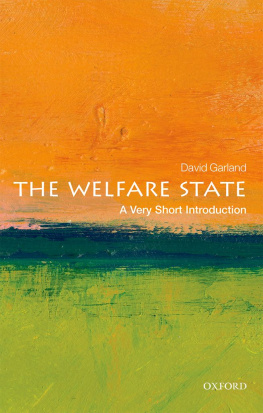Bent Greve - De Gruyter Handbook of Contemporary Welfare States
Here you can read online Bent Greve - De Gruyter Handbook of Contemporary Welfare States full text of the book (entire story) in english for free. Download pdf and epub, get meaning, cover and reviews about this ebook. year: 2022, publisher: De Gruyter, genre: Politics. Description of the work, (preface) as well as reviews are available. Best literature library LitArk.com created for fans of good reading and offers a wide selection of genres:
Romance novel
Science fiction
Adventure
Detective
Science
History
Home and family
Prose
Art
Politics
Computer
Non-fiction
Religion
Business
Children
Humor
Choose a favorite category and find really read worthwhile books. Enjoy immersion in the world of imagination, feel the emotions of the characters or learn something new for yourself, make an fascinating discovery.

- Book:De Gruyter Handbook of Contemporary Welfare States
- Author:
- Publisher:De Gruyter
- Genre:
- Year:2022
- Rating:3 / 5
- Favourites:Add to favourites
- Your mark:
- 60
- 1
- 2
- 3
- 4
- 5
De Gruyter Handbook of Contemporary Welfare States: summary, description and annotation
We offer to read an annotation, description, summary or preface (depends on what the author of the book "De Gruyter Handbook of Contemporary Welfare States" wrote himself). If you haven't found the necessary information about the book — write in the comments, we will try to find it.
De Gruyter Handbook of Contemporary Welfare States — read online for free the complete book (whole text) full work
Below is the text of the book, divided by pages. System saving the place of the last page read, allows you to conveniently read the book "De Gruyter Handbook of Contemporary Welfare States" online for free, without having to search again every time where you left off. Put a bookmark, and you can go to the page where you finished reading at any time.
Font size:
Interval:
Bookmark:

De Gruyter Contemporary Social Sciences Handbooks
Volume
ISBN 9783110721249
e-ISBN (PDF) 9783110721768
e-ISBN (EPUB) 9783110721829
Bibliographic information published by the Deutsche Nationalbibliothek
The Deutsche Nationalbibliothek lists this publication in the Deutsche Nationalbibliografie; detailed bibliographic data are available on the Internet at http://dnb.dnb.de.
2022 Walter de Gruyter GmbH, Berlin/Boston
This first chapter of the book takes the temperature of contemporary welfare states, while also trying to assess the strength of the challenges for different types of welfare regimes. It will also point to future opportunities with the accompanying uncertainty and in which areas more information is needed. Besides discussing central challenges for welfare states in the years to come the chapter also gives a short overview of each of the chapters in the book.
Welfare states have evolved and developed over at least the last 150 years, although not with all countries at all times following the same path, implying that they are still very diverse in structure, universality and generosity. There was a golden age of welfare state growth shortly after the Second World War, which lasted until around 1973. Then after the oil-price shock in the 1970s welfare states have, at least since the OECDs path-breaking book (OECD 1981), been argued to be in crisis. This argument has been followed up with discussions on the dismantling of welfare states (Pierson 1994) or an era of permanent austerity (Pierson 2001). The debates on whether welfare states are in crisis continued after the financial crisis, causing further changes, often under the label of austerity and retrenchment in the literature. Albeit the data do not, in general, confirm that this has actually taken place looking at overall spending on welfare state policies (Greve 2020), the data also indicate that there can be areas within welfare states where retrenchment has taken place, depending on the legitimacy of different parts of the welfare states.
Over the years, the factors that were either expected to have, or are having, an impact on this development have been many and varied. For the same reasons, these factors have not been of similar strength across countries and welfare states. However, there are some common trends that have influenced, and can be expected to influence, contemporary welfare states development in the years to come. These include aspects of globalisation, regionalisation, new technology, demography, voters expectation and the re-structuring of societies. There are, however, also new challenges to welfare states. The financial crisis showed the vulnerability of welfare states economic systems, but also that the ability to have a stable economy influences the options and ability to continue and be able to afford a welfare state.
The recent COVID-19 crisis has demonstrated a double pressure on welfare states, including whether there is a strong need for higher spending in several areas at the same time in this case, health and the economy when there is also strong pressure on the sustainability of the welfare state, or at least part hereof, at play. This combined with increasing economic inequality has implied both economic and political problems in a number of countries, thereby creating new variants of the existing and possible crises in the future. Each crisis, including the assessment of whether it is, in fact, a crisis, may vary according to ideology, but also how the individual country is positioned in relation to solving it. The changes in 2009 seemingly opened the way for discussion on the role of the market, and the COVID-19 crisis showed the need for state intervention in a Keynesian way to ensure the necessary demand was available in order to reduce the potential negative impact on societal development of the restrictions imposed in order to cope with the pandemic. At the same time, a number of the aspects already mentioned continue to be possible threats and pressures on welfare states such as demographic change and the development of new technology.
This book thus takes the temperature of contemporary welfare states, while also trying to assess the strength of the challenges for different types of welfare regimes. It will also point to future opportunities with the accompanying uncertainty and in which areas more information is needed.
In section 1.2, a further elaboration of the possible challenges is presented, whereas section 1.3 gives a short overview of each of the chapters in the book. Lastly, section 1.4. concludes the chapter.
For a number of years, the core challenges for welfare states in the developed world have been globalisation and changes in demography, with a growing number of persons permanently outside the labour market due to retirement. Increasing regional diversity in a number of countries is also a challenge.
This has resulted in pressure on welfare states, especially in relation to pension expenditure, where a number of reforms have been implemented in many countries (Ebbinghaus 2021), as has withdrawing earlier liberal reforms (Bridgen 2019), with a higher degree of inequality as a consequence (Hinrichs 2021). Overall, the focus in pension reforms has been on increasing the retirement age, changes from defined benefits to defined contributions, changes to the rules on indexations, etc. At the same time as this pressure in relation to reducing spending on income transfers and attempts to reduce the public expenditure pressure by increasing number of pensioners, there has also been, in a combination of demographic changes and expectations among citizens, an increased desire for increases in services in relation to health and elderly care (OECD 2021).
Furthermore, health and long-term care often have widespread support among populations, which is generally the case in all countries (OECD 2021), and the legitimacy of welfare states is thus challenged in the sense that disappointment among the population that has expected, for example, the best and latest health care, which is not met, risks delegitimising the welfare state. Health care is also a field where we want to spend more as we get richer (as individuals or countries).
While the globalisation of production has increased the pressure, especially on the unskilled labour forces options to get a job ( and Restrepo 2017), higher migration has also been seen as a pressure on welfare states. Within the EU, the free movement of labour has been perceived as a threat to native workers, with slogans such as they take our jobs (Chomsky 2007; Greve 2019) being used. This reflects that even if there are no overall job losses, there may be distributional aspects of labour market turnover that can contribute to a change in the perception of what welfare states can and perhaps cannot do. This is an indication of one of the issues that has contributed to the increase in the level of inequality. Change on the labour market is thereby a new and strong item on the agenda for the development of welfare states (Greve 2021).
In addition, not only does globalisation influence the labour market, but new technology (including use of platforms, automation, artificial intelligence) is also a challenge, and although there is disagreement about the extent and consequences of this (Greve 2017; Frey 2019), especially people without the appropriate education and qualifications will constantly and to a greater extent be at risk of losing their jobs, and thus, in many countries, often their financial safety net as well (OECD 2019a). Even if there have not been direct cuts in the level of benefits in many countries, the benefits have not always continued to keep pace with real increases in wages on the labour markets and thereby, relatively speaking, they have been in decline. New technology has also contributed to the fact that the middle class in particular has been under pressure (Palier 2019) and has only to a lesser extent than higher income groups, if at all, seen a real improvement in the last 2030 years, and with the prospect that their children will not get better positions than themselves (OECD 2019b).
Font size:
Interval:
Bookmark:
Similar books «De Gruyter Handbook of Contemporary Welfare States»
Look at similar books to De Gruyter Handbook of Contemporary Welfare States. We have selected literature similar in name and meaning in the hope of providing readers with more options to find new, interesting, not yet read works.
Discussion, reviews of the book De Gruyter Handbook of Contemporary Welfare States and just readers' own opinions. Leave your comments, write what you think about the work, its meaning or the main characters. Specify what exactly you liked and what you didn't like, and why you think so.







